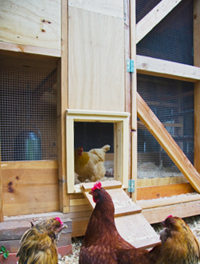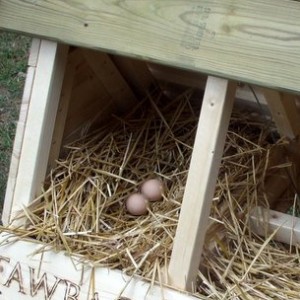An automatic chicken coop door – now why didn’t I think of that ?!?
 Maybe you’ve heard of them, but I didn’t know they even existed until yesterday evening when I was round at a chicken-keeping friend’s house. Now I’ve seen one I suppose the idea is pretty obvious, but honestly, I hadn’t even thought of it!
Maybe you’ve heard of them, but I didn’t know they even existed until yesterday evening when I was round at a chicken-keeping friend’s house. Now I’ve seen one I suppose the idea is pretty obvious, but honestly, I hadn’t even thought of it!
My pal had got his from Germany – and although it was beautifully made and worked well, it was very expensive – over $300.00. I guess he must really value his beauty sleep!
I though there must be cheaper automatic chicken coop doors on the market so I had a bit of a search around online.
Two types of automatic chicken coop door
What I found was that you can do things a lot cheaper if you are a bit handy with motors, timers and such. Alternatively, you can buy an automatic chicken coop door kit. Not quite as cheap as buying all the separate bits and working it out yourself, but much less fiddling about.
 There are a few kits around, and they fall into two basic categories. Automatic chicken coop doors with a light sensor, or those with a timer.
There are a few kits around, and they fall into two basic categories. Automatic chicken coop doors with a light sensor, or those with a timer.
At first, I though the light sensor one was a great idea. Sun comes up, automatic chicken coop door opens. Sun goes down, door closes. Excellent, yes?
But what if your chicken coop is shaded by trees or another building? What if it’s cloudy or stormy? Actually the makers say these things needn’t necessarily make that much difference, and they’re probably right, but I’m not sure…
The other kind has a simple timer. Set it to open when you like and close when you like. Now you might need to re-set it a couple of times a year depending on dawn and dusk where you are, but that’s hardly a problem, is it.
The one I’ve seen that I particularly like the look of is made by Automatic Chicken House Doors. It’s mostly made from thick ply that’s been treated for weather protection and there are kits for either sliding or flap-opening doors. They reckon you could install it in around 15 minutes and there’s even a ten minute video on the site showing you exactly how.
Is An Automatic Chicken Coop Door Worth The Money?
Either of the choices from Automatic Chicken House Doors is way less than my friend’s German version, but it’s still a fair few bucks just so you can lie in bed a bit longer in the morning! If you’re up with the dawn anyway, and home at dusk, it might seem like a waste of money.
But a lot of folks have to go a fair distance to work and are often home late. What about if you’re going out to dinner? What about when you’re away on vacation? Maybe a neighbor can do it, maybe not. Anyway, it’s not really for your convenience, as much as anything it’s for the safety of your chickens. There are plenty of predators that can get into a chicken run, but they won’t get into a properly built chicken coop if the door is shut.
A day ago I had never heard of them. Now I have, an automatic chicken coop door is definitely on my shopping list.
 It’s the cover that first grabs you – but that’s what covers are supposed to do! I thought it looked like an unusual approach to chicken coop plans and worth looking further.
It’s the cover that first grabs you – but that’s what covers are supposed to do! I thought it looked like an unusual approach to chicken coop plans and worth looking further.

 What you want is a sheltered area that your chicken are comfortable to lay in. By sheltered that means even inside a chicken coop it should be a separate boxed off area, shaded if possible to make it darker and again, if possible, away from roosting perches – you don’t actually want the hens to sleep in there because they’ll likely make a mess. 12 inches square is a good size – so your birds can actually stand up if they want to. Bigger is better if you’ve got the space.
What you want is a sheltered area that your chicken are comfortable to lay in. By sheltered that means even inside a chicken coop it should be a separate boxed off area, shaded if possible to make it darker and again, if possible, away from roosting perches – you don’t actually want the hens to sleep in there because they’ll likely make a mess. 12 inches square is a good size – so your birds can actually stand up if they want to. Bigger is better if you’ve got the space.

 1. Let’s look at fence design. Whether you’re considering chicken coops with runs, or just the general fencing of the area where you’ll keep your hens, a strong fence or enclosure is vital for their safety. Sadly there are lots of beasts – and a few birds – that will happily make a meal of your chickens or their eggs. Don’t spend ages on the hen house then short cut the fence.
1. Let’s look at fence design. Whether you’re considering chicken coops with runs, or just the general fencing of the area where you’ll keep your hens, a strong fence or enclosure is vital for their safety. Sadly there are lots of beasts – and a few birds – that will happily make a meal of your chickens or their eggs. Don’t spend ages on the hen house then short cut the fence.

 Hi there, welcome to Best Plans For Chicken Coops!
Hi there, welcome to Best Plans For Chicken Coops!